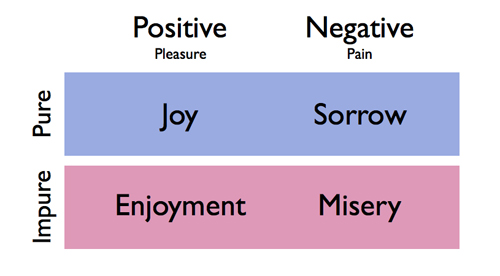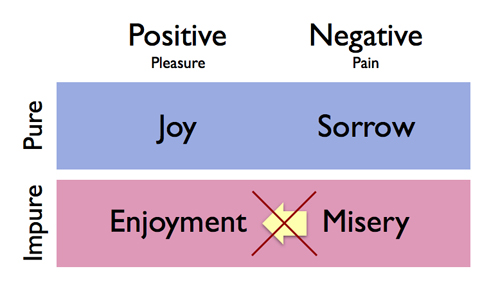Jeffrey Thayne
 |
| Is the path of the gospel a flower-strewn, smoothly-paved, uninterrupted straight-shot to constant happiness? |
I would like to talk today about sorrow, joy, misery, enjoyment, pain, pleasure, and love. It’s ambitious project, I know. However, I would like to present a fresh perspective on how each of these terms relate to each other. However, please note the recent post by Nathan Richardson called “Go Away… I mean, Come Here,” and realize that I use these terms differently in this post than they might be used in other contexts, such as scripture.
The Problem
In a couple of previous posts (Challenging the Pleasure Principle and Sorrow versus Misery), I’ve addressed the issue of hedonism, which is defined as “the ethical theory that pleasure (in the sense of the satisfaction of desires) is the highest good and proper aim of human life. I believe that many of us may inadvertently take the hedonist position that pleasure (or positive emotion) is inherently good, while pain (or negative emotion) is inherently bad.
Here’s an example: one of the challenges of theodicy is that of explaining what some philosophers have termed “natural evil.” Examples of natural evil include “cancer, birth defects, tornadoes, earthquakes, tsunamis, hurricanes,” and other tragic circumstances that have “no human perpetrator to blame for it.” The name “natural evil” implies that the pain that accompanies such tragedies is inherently bad, and is an evil in and of itself.
Another example includes most common understandings of the Fall, and of Adam and Eve’s experience in the garden of Eden. Many Christians, including some Latter-day Saints, assume that the “natural evil” and pain that resulted from the Fall of Adam and Eve and their subsequent mortality is the product of a sin of some kind. Latter-day Saints will claim that God wanted Adam and Eve to violate His will (and thereby experience the pain of mortality), but they nonetheless assume that it was an evil act that caused the Fall, and that only an evil act could have caused it.
Another example includes the unfortunately common but misguided belief that the gospel of Jesus Christ is designed to take away pain in our lives. Some Latter-day Saints assume that living the gospel and turning to Christ will lead to a life of uninterrupted enjoyment and happiness, and do not realize that living a pure life can lead to pain. In a subtle way, this is a hedonistic outlook, because it assumes that pain is inherently bad and is always the product of evil.
Positive and Negative Experiences
First, I believe that pleasure and pain are morally neutral. One can experience both with either a pure heart or an impure heart. I don’t believe that pain is always the product of sin or transgression (either on our own part, or on the part of Adam and Eve). I think a chart might help clarify:
I believe the chart is pretty self-explanatory. Simply put, good people can suffer, and that suffering can have little to do with sin. As I mentioned before, I think that many people assume that living the gospel of Jesus Christ will take us out of the right hand column, and into the left hand column, as illustrated below:
I call this assumption the Yellow Brick Road Syndrome. A quick purview of almost any scriptural story will demonstrate that it is false. Almost every righteous individual in the scriptures suffered far more than I ever have. In fact, modern-day revelation includes a story when God Himself weeps with sorrow. Enoch reports that he saw the “God of heaven [look] upon the residue of the people, and he wept.” The idea that righteousness inoculates us against pain is not only of non-Christian origin, it defies some of the basic tenets of the Christian faith.
I love the comments of Carlfred Broderick, who said, “The gospel of Jesus Christ is not insurance against pain. It is a resource in the event of pain, and when that pain comes (and it will come because we came here on earth to have pain among other things), when it comes, rejoice that you have resource to deal with your pain.” Spencer W. Kimball also challenged the idea that the gospel is designed to move us from the right-hand column and into the left-hand column:
Being human, we would expel from our lives sorrow, distress, physical pain, and mental anguish and assure ourselves of continual ease and comfort. But if we closed the doors upon such, we might be evicting our greatest friends and benefactors. Suffering can make saints of people as they learn patience, long-suffering, and self-mastery. The sufferings of our Savior were part of his education.
So, if Christ doesn’t take away our pain, what does He do? I believe that although Christ doesn’t always remove pain from our lives, He does make the experience of pain qualitatively different. For example, I believe Christ can turn what I would call misery into something I would call sorrow instead. Here’s how this could be diagrammed on the chart:
Christ can purify our hearts, and by so doing change the way we experience pain. While the amount of pain may not have changed, the kind of pain we experience is different. I believe that sorrow (as opposed to misery) is a kind of pain that is much easier to endure than misery. I would never call it a “pleasant” experience (it is certainly a negative one), but I would also never call it an “evil” experience.
Modes of Love
What is the qualitative difference? I’m not entirely sure I know the answer to that question. However, that hasn’t stopped me from taking a stab at at least one possibility. When we Enoch’s account about God weeping, I believe we see that God’s sorrow is born of love. God is experiencing sorrow because He loves His children. I think that is the qualitative difference that Christ makes in our own experience of pain. Here’s how I might label the two different rows on the chart:
In other words, when Christ purifies our hearts, He redeems our pain by turning it into love. When Christ takes our inward-looking, self-centered lifestyle and mindset and morphs it into an outward-looking, other-centered lifestyle and mindset, the qualitative experience of pain changes dramatically. I’m now going to make a bold claim: I believe that both joy and sorrow are both modes of love. This is because joy experienced with a pure heart is always centered on others. Sorrow experienced with a pure heart is always centered on others. The other-centric nature of joy and sorrow is what makes them pure. In this way, I believe that joy is not altogether separate and distinct from love, but is rather a subset or form of love.
Consider, for example, Ammon’s experience of joy after observing the success their missionary work: ” I do not boast in my own strength, nor in my own wisdom; but behold, my joy is full, yea, my heart is brim with joy, and I will rejoice in my God. … Behold, how many thousands of our brethren has he loosed from the pains of hell; and they are brought to sing redeeming love, … therefore have we not great reason to rejoice?” Likewise, sorrow is also a subset or form of love. God’s tears of sorrow for the sins of His children is just one of many examples of other-centered sorrow in the scriptures.
We can see that the converse may also be true: enjoyment and misery could both be forms or modes of self-centeredness (or malice). I’m not going to go into detail at this point, because I wish to avoid any potential controversy on this issue. My main point is that a crucial part of our experience on this earth is to experience pain, because God is teaching His children how to love, and sorrow is one of the modes of love.
Why We’re Here
We came to earth to experience pain. However, this does not mean that we came here to experience sin. Pain can be experienced without sin (and often is). Adam and Eve crossed over into a different world (the literal meaning of the word transgress) in order to experience the difference between joy and sorrow (the two ways of loving), but this does not mean that Sorrow is the result of sin or evil. Of course, part of mortal life includes the capacity to sin, and we all indulge in sin on a daily basis. However, the consequences of sin are found in the bottom row of the chart, not the top row.
The consequences of sin certainly provide an occasion for the pure of heart to experience sorrow. But so do other kinds of pain, such as pain which results in illness, death, accidents, or acts of nature. It seems clear that the central lesson we need to learn does not require the existence of sin—only the possibility of sin. Now, because we all sin, God has provided us with a Savior who can rescue us from the impurities in our hearts. But sin is not why we are here. The real lesson we’re sent here to learn is love. Of course, we can’t get into the top row of the chart (the row of love) without giving up sin, so repentance is at the heart of our purpose here.
In summary, the gospel of Jesus Christ is all about pulling us out of the bottom row of the chart, and inviting us into the top row. We talk a great deal in the church about happiness, and I actually believe that the happiness that we seek is better described by the word peace. Wether we are experiencing love in the form of joy or sorrow, I believe we are also experiencing peace. God, even in the midst of His sorrow and weeping for our sins, still experienced peace. I believe that the way Christ makes our pain more endurable is by turning it into love, and by doing so we can experience peace, even in the midst of our pain. I think the peace that comes through love is what constitutes the happiness that God promises the righteous, and it can be experienced through joy or sorrow.

